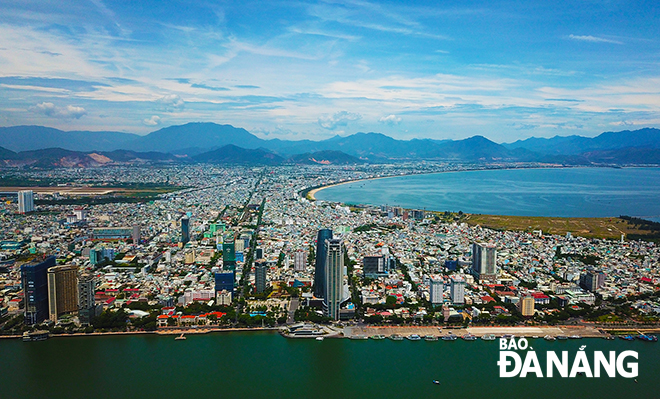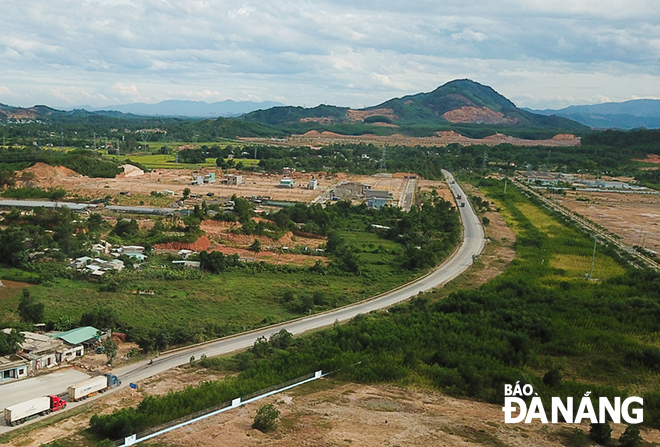Adjustments to Da Nang's master plan must ensure harmony between conservation and development: the PM
The Vietnamese Government Office has announced instructions made by Prime Minister (PM) Nguyen Xuan Phuc at a recent meeting on appraising the adjustments to the master plan for Da Nang’s major developments by 2030, with a vision to 2045.
 |
| A corner of the city centre along the Da Nang Bay |
Da Nang is a city of ports, tourism and services. It is a big city, playing the most important role in driving Central Viet Nam’s progress in terms of defence, security and socio-economic development, and serving as the country's main and important gateway to the world. Hence, it is necessary to develop a livable, safe and smart city in Viet Nam.
The national government is very interested in supporting Da Nang’s socio-economic development, the PM affirmed. Da Nang is one of the three Vietnamese cities, along with the capital city of Ha Noi and Ho Chi Minh City, to have been selected by the ASEAN Smart Cities Network (ASCN) for the building of smart cities. This is a new development trend in the world, creating a favourable investment environment for socio-economic development.
In addition to focusing on tourism and seaport development, Da Nang should attract more high-tech and industrial projects which are environmentally friendly in the time to come.
“The adjusted master plan must ensure the harmony between conservation and development, with a focus on the lives of local residents and the development strategies towards a major hub of Central Viet Nam and Central Highlands”, PM Phuc also remarked.
 |
| The western part of the city boasts great potential for developing high-tech and IT industries |
Under the adjusted master plan, Da Nang landscape structure comprises three typical urban areas, namely waterfront area, green core zone and hillside, plus an ecological region.
Also, there are two so-called ‘economic belts’, namely the northern part boasting high-tech industry and seaport- logistics, and the southern part showing off innovations and high-tech agriculture.
The national government chief asked Da Nang government to work closely with the Ministry of Construction to collect all constructive ideas and recommendations from agencies, organisations and experts in a bid to comprehensively review and complete the adjustments of Da Nang's master plan for major development.
In particular, the adjustments must identify solutions to protect natural landscapes of forests and sea, resolve urban inundation and issues relating to water drainage, waste water treatment and traffic jams, and show the city’s climate change and sea level rise response scenarios.
Also, heed should be paid to identifying dangerous and high-risk geological areas, clarify Da Nang’s capacity of boosting linkage with localities in Central Viet Nam and Central Highlands, those across the country as a whole, and the ASEAN region and the world at large. In detail, it is necessary to clarify the relationship between Da Nang and its neighbours namely Quang Nam and Thua Thien-Hue, with the Central Highlands, Phong Nha - Ke Bang, and Southern Laos.
 |
| The adjusted master plan of Da Nang must ensure the harmony between conservation and development. In the photo is an urban area of Ngu Hanh Son District along the axis of Co Co River. |
Effective measures should be taken to ensure efficient and economical use of natural resources such as land and groundwater.
It is high time for Da Nang to pay more attention to developing high technology, appropriate industries, wind power, oil and gas, and give priority to innovation and creativity.
Besides, it is a good idea to setting up it is a good idea to develop a ‘compact city’ model in order to effectively tap land resources in the coming time, and setting up more public and green-covered spaces in urban areas.
Last, but not least, Da Nang should develop the Lien Chieu deep-sea mega-port project at a scale suitable to Viet Nam's seaport system development master plan approved by the Prime Minister, as a move to gradually reduce the overload at the existing Tien Sa port, 10 kilometers away from the city centre.
By TRIEU TUNG- Translated by A.T